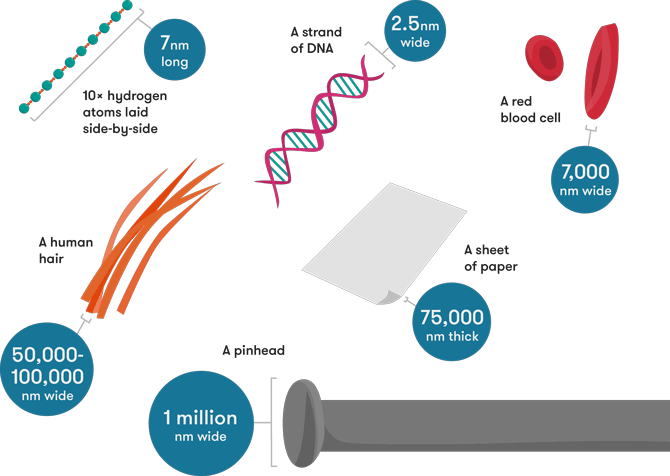How small is nanoscale small?
Well, it’s so tiny that it might take a moment to get your head around—let’s go slowly.
The nanoscale is the dimensional range of approximately 1 to 100 nanometres. But what does this really mean?
To begin, take a look at the back of your hand. Using just your eyes you can focus down to a scale of 1 centimetre to 1 millimetre. At this scale the skin looks flat. However, get out a magnifying glass and you can see it’s actually wrinkly with cracks and folds. The magnifying glass allows you to study the fine structure of the skin at less than a millimetre (or one-thousandth of a metre).
If you were to look more closely with a microscope you could examine the cells that make up your skin. Now you’re working at the scale of micrometres (one-thousandth of a millimetre), sometimes referred to as the microworld.
Cells and bacteria are measured in micrometres.
To reach the nanoworld you have to go smaller again. A nanometre (nm) is 10⁻⁹ metres, which is one-thousandth of a micrometre, or one-billionth of a metre. This is the scale at which we measure atoms and the molecules they make.
To give you some idea of the nanoscale, a strand of DNA is 2.5 nm in diameter and a red blood cell is about 7000 nm wide. Need a few more examples? A human hair is between 50,000 and 100,000 nanometres thick, a single sheet of paper is around 75,000 nanometres thick, while a pinhead is around a million nanometres wide. If each person on Earth was the size of a nanometre, everyone on the planet would fit into one Hot Wheels matchbox car. So you get the idea—nano is super, super tiny.
Nanoscience has the potential to reshape the world around us. It could lead to revolutionary breakthroughs in fields ranging from manufacturing to health care. So the old adage might just be true after all—good things come in small packages.






